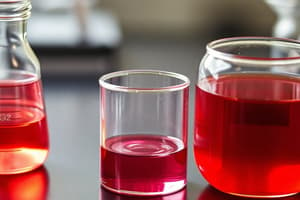Podcast
Questions and Answers
Which method is traditionally used for the separation of the components of volatile mixtures?
Which method is traditionally used for the separation of the components of volatile mixtures?
- Distillation (correct)
- Fractional crystallization
- Sublimation
- Fractional liberation
In which method are the sample mixtures distributed between two phases, one of which remains stationary while the other phase percolates through or over the surface of the fixed phase?
In which method are the sample mixtures distributed between two phases, one of which remains stationary while the other phase percolates through or over the surface of the fixed phase?
- Distillation
- Chromatography (correct)
- Sublimation
- Fractional liberation
When a mixture of alkaloid bases is shaken with NaOH solution, which group of compounds will be separated as salts?
When a mixture of alkaloid bases is shaken with NaOH solution, which group of compounds will be separated as salts?
- Caffeine
- Volatile oils
- Phenolic alkaloids (correct)
- Crude extract materials
What is the function of the stationary phase in chromatography?
What is the function of the stationary phase in chromatography?
What does the term 'analyte' refer to in chromatography?
What does the term 'analyte' refer to in chromatography?
Which method is NOT a method of detection in chromatography?
Which method is NOT a method of detection in chromatography?
Who is credited with the first detailed description of chromatography?
Who is credited with the first detailed description of chromatography?
What are the two types of chromatography that are usually adsorption chromatography?
What are the two types of chromatography that are usually adsorption chromatography?
What is the mobile phase for Gas Solid Chromatography (GSC)?
What is the mobile phase for Gas Solid Chromatography (GSC)?
What are the possible phases for the stationary phase in chromatography?
What are the possible phases for the stationary phase in chromatography?
What method exploits the differences in solubility of the components of a mixture in a particular solvent?
What method exploits the differences in solubility of the components of a mixture in a particular solvent?
Which technique involves the distribution of a compound between two phases, a moving (mobile) phase that is passed over an immobile (stationary) phase?
Which technique involves the distribution of a compound between two phases, a moving (mobile) phase that is passed over an immobile (stationary) phase?
In which method are the sample mixtures dispersed between two phases, with one phase remaining stationary while the other phase percolates through or over the surface of the fixed phase?
In which method are the sample mixtures dispersed between two phases, with one phase remaining stationary while the other phase percolates through or over the surface of the fixed phase?
What did Michael Tswett separate from a mixture of plant pigments in 1906?
What did Michael Tswett separate from a mixture of plant pigments in 1906?
Which combinations of mobile and stationary phases are not possible in chromatography?
Which combinations of mobile and stationary phases are not possible in chromatography?
What types of chromatography are LSC and GSC usually associated with?
What types of chromatography are LSC and GSC usually associated with?
What determines the ways to carry out a chromatographic process?
What determines the ways to carry out a chromatographic process?
What is the role of the stationary phase in chromatography?
What is the role of the stationary phase in chromatography?
What is the function of the mobile phase in chromatography?
What is the function of the mobile phase in chromatography?
What does a chromatogram represent?
What does a chromatogram represent?
Flashcards are hidden until you start studying
Study Notes
Chromatography
- Traditionally, the separation of volatile mixtures is achieved through chromatography.
- In chromatography, sample mixtures are distributed between two phases, one of which remains stationary while the other phase percolates through or over the surface of the fixed phase.
Separation of Alkaloid Bases
- When a mixture of alkaloid bases is shaken with NaOH solution, the alkaloid bases are separated as salts.
Function of Stationary and Mobile Phases
- The stationary phase in chromatography holds the mixture components, allowing them to interact with the mobile phase.
- The function of the mobile phase is to transport the mixture components through the stationary phase.
Chromatography Definitions
- An analyte is the substance being analyzed in chromatography.
- The term chromatography was first described in detail by Michael Tswett.
Types of Chromatography
- There are two types of chromatography that are usually adsorption chromatography: Liquid-Solid Chromatography (LSC) and Gas-Solid Chromatography (GSC).
- In Gas Solid Chromatography (GSC), the mobile phase is a gas.
- The stationary phase in chromatography can be a solid or a liquid.
Chromatography Process
- A chromatographic process involves the distribution of a compound between two phases, a moving (mobile) phase that is passed over an immobile (stationary) phase.
- The method that exploits the differences in solubility of the components of a mixture in a particular solvent is chromatography.
History of Chromatography
- Michael Tswett separated chlorophyll from a mixture of plant pigments in 1906.
Chromatography Limitations
- It is not possible to combine a solid stationary phase with a gas mobile phase in chromatography.
Chromatography Types
- LSC and GSC are usually associated with adsorption chromatography.
Chromatographic Process Determinants
- The ways to carry out a chromatographic process are determined by the mobile and stationary phases.
Chromatogram
- A chromatogram represents the result of a chromatographic process, showing the separation of mixture components.
Studying That Suits You
Use AI to generate personalized quizzes and flashcards to suit your learning preferences.




